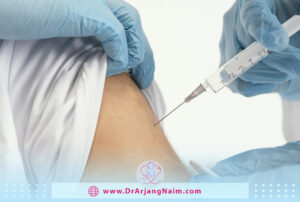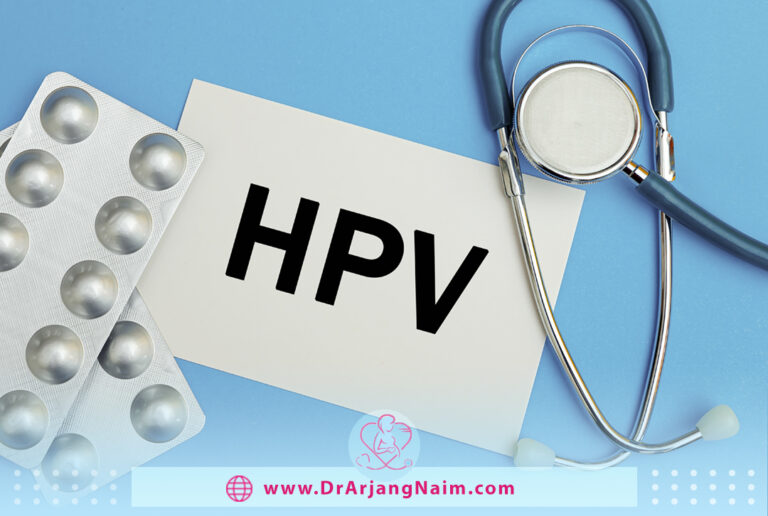Human papillomavirus (HPV) is a common sexually transmitted infection. It’s important to note that there are various strains of HPV, some of which can cause genital warts, while others can lead to cervical cancer. In women, HPV infections are frequently diagnosed through routine Pap tests or HPV tests. Many women contract HPV at some point in their lives, but in most cases, the immune system clears the infection without causing any symptoms or health issues. However, in some instances, especially when the infection persists, it can lead to cervical abnormalities or, rarely, cervical cancer.
Preventive measures such as HPV vaccination (most effective when administered before becoming sexually active) and regular screenings, like Pap smears or HPV tests, significantly reduce the risk of complications from HPV infections. Women must attend regular check-ups with their healthcare providers to monitor and manage their reproductive health, including HPV screenings.

How does Human papillomavirus spread?
HPV is spread through sexual and intimate skin-to-skin contact. There are more than 200 different types of HPV. Different types of HPV have different risks.
Low-risk HPV rarely turns into cancer, but it can cause symptoms such as genital warts around the genitals and anus. However, these symptoms are not always visible. For example, they may occur inside the anus, vagina, or cervix.
High-risk HPV may not show any symptoms. However, without treatment, it can cause several cancers, including:
- Neck
- Vaginal
- Vulva
- Oropharynx
- Anal
Whether or not HPV causes symptoms has nothing to do with how much or how little it is. Microscopic examination and laboratory tests are the only ways to determine the risk or presence of cancer.

Symptoms
In most cases, the immune system defeats the Human papillomavirus infection before warts develop. When warts appear, they look different depending on the type of HPV involved:
- Genital warts appear as flat lesions or small cauliflower-like or stalk-like bumps. In women, genital warts most often appear in the vulva, but they can also appear near the anus, cervix, or vagina.
In men, genital warts appear on the penis and scrotum or around the anus. Genital warts rarely cause discomfort or pain but may itch or become tender.
- Common warts: Common warts appear rough and raised bumps and usually occur on the hands and fingers. In most cases, common warts are unsightly, but they can also be painful or prone to bruising or bleeding.
- Calluses on the soles of the feet: Plantar warts are hard, granular warts that usually appear on the heels or balls of your feet. These warts may cause discomfort.
- Flat warts are lesions with a smooth and slightly raised surface. They can appear anywhere, but children usually get them on the face, and men tend to get them in the beard area. Women tend to put them on their feet.
Causes
Human Papillomavirus is primarily transmitted through intimate skin-to-skin contact. The virus infects the epithelial cells found on the skin and mucous membranes. Here are the main ways in which HPV is spread:
- Sexual Contact: HPV is most commonly spread through sexual activity, including vaginal, anal, and oral sex. Both penetrative and non-penetrative sexual activities can transmit the virus. It’s important to note that genital HPV infection is not limited to intercourse; any form of intimate skin-to-skin contact can potentially lead to transmission.
- Direct Skin-to-Skin Contact: HPV can be transmitted through direct skin-to-skin contact with an infected person. This can occur in areas not covered by condoms or dental dams. Genital warts, for example, can be a visible sign of infection, but HPV can also be present on the skin without any visible symptoms.
- Vertical Transmission: A mother infected with certain types of genital HPV can potentially transmit the virus to her newborn during childbirth. However, this is relatively uncommon.
- Non-sexual Transmission: While sexual contact is the most common mode of transmission, it’s also possible to contract certain types of HPV through non-sexual means. For example, common warts on the hands or feet are caused by different types of HPV than those that cause genital warts, and they are typically spread through direct contact with a wart.
It’s important to note that HPV is very common, and many people who are infected with the virus do not experience any symptoms. In most cases, the immune system can clear the infection on its own. However, certain high-risk types of HPV can persist and lead to more serious health issues, such as cervical cancer.
Risk factors
Human papillomavirus infection is common. Risk factors for HPV infection include:
- Number of sexual partners: The more sexual partners you have, the more likely you are to get genital HPV infection. Having sex with a partner who has had multiple sexual partners also increases the risk.
- Age: Warts are more common in children. Genital warts often occur in teenagers and young adults.
- Weakened immune system: People with a weakened immune system are more at risk of HPV infection. The immune system can be weakened by HIV/AIDS or immunosuppressive drugs used after an organ transplant.
- Damaged skin: Areas of skin that are punctured or open are more prone to common warts.
- Personal contact: Touching personal warts or not using protection before touching surfaces that have been exposed to HPV—such as public showers or swimming pools—may increase the risk of HPV infection.
Complication
Human Papillomavirus (HPV) infections can lead to various complications, ranging from benign warts to more serious health issues, particularly when the infection persists. Here are some potential complications associated with HPV:
- Genital Warts: Certain types of HPV can cause genital warts. While these warts are generally benign, they can be uncomfortable and may require treatment. Treatment options include topical medications, freezing, laser therapy, or surgical removal.
- Respiratory Papillomatosis: In rare cases, HPV infections, particularly with high-risk types, can lead to respiratory papillomatosis. This condition involves the growth of warts in the airways, which can cause breathing difficulties. It is most commonly seen in children but can also affect adults. Surgical interventions are often necessary to manage respiratory papillomatosis.
- Cervical Dysplasia and Cancer: Persistent infection with high-risk HPV types is a major risk factor for the development of cervical dysplasia and cervical cancer. Cervical dysplasia refers to abnormal changes in the cells of the cervix that can progress to cancer if not treated. Regular screenings, such as Pap smears and HPV tests, are crucial for early detection and intervention.
- Other Cancers: In addition to cervical cancer, certain high-risk types of HPV are associated with an increased risk of different cancers, including cancers of the anus, vulva, vagina, penis, and oropharynx (the back of the throat, base of the tongue, and tonsils).
It’s important to note that the majority of HPV infections resolve on their own without causing complications. The immune system is often effective in clearing the virus. Additionally, the availability of HPV vaccines has significantly reduced the incidence of infections with the types covered by the vaccines, thereby reducing the risk of associated complications.

Prevention
Preventing Human Papillomavirus (HPV) infection involves a combination of vaccination and practicing safe sexual behaviors.
HPV vaccination
- Vaccination for Adolescents: HPV vaccines are highly effective in preventing infection with the most common virus types. The vaccines are typically administered in a series of shots. The CDC recommends routine vaccination for all adolescents aged 11-12, with catch-up vaccination up to age 26 for those who did not receive it earlier.
- Vaccination for Adults: While the vaccines are most effective when given before sexual activity begins, they are still recommended for individuals up to age 26 who have not been vaccinated previously.
- Types of Vaccines: There are different HPV vaccines available, including those that protect against the most common high-risk types and those that also protect against certain low-risk types causing genital warts.
Safe sexual practices
Use of Condoms: While condoms do not provide complete protection, they can reduce the risk of HPV transmission. However, they may not cover all potentially infected areas, so the risk is not eliminated.
Limit Sexual Partners: Limiting the number of sexual partners and choosing partners who have had few or no previous partners can reduce the risk of exposure to HPV and other sexually transmitted infections.
Regular screenings
For individuals with a cervix, regular screenings such as Pap smears and HPV tests are crucial for detecting cervical abnormalities and cancer early. Follow the recommended screening guidelines provided by healthcare professionals.
Education and Awareness
Understanding the risks associated with HPV, the importance of vaccination, and practicing safe sex can contribute to prevention. Promote awareness and education about HPV in your community.
Diagnosis
A doctor may be able to diagnose human papillomavirus (HPV) infection by looking at the warts. If the genital wart is not visible, you will need one or more of the following tests:
- Vinegar (acetic acid) solution test: Vinegar solution applied to genital areas infected with HPV will whiten them. This may help identify hard-to-see flat lesions.
- Pap smear test: Your doctor collects a sample of cells from the cervix or vagina to send for laboratory analysis. A Pap test can show abnormalities that could lead to cancer.
- DNA test: This test, performed on cervical cells, can detect the DNA of high-risk types of HPV that are associated with genital cancers. In addition to the Pap test, it is recommended for women 30 years and older.

Treatment
Warts often go away without treatment, particularly in children. However, there’s no cure for the virus so that they can reappear in the same or other places.
Medications
Medications to eliminate warts are typically applied directly to the lesion and take many applications before success.
Surgical and other procedures
If medications don’t work, your doctor might suggest removing warts by one of these methods:
- Freezing with liquid nitrogen (cryotherapy)
- Burning with an electrical current (electrocautery)
- Surgical removal
- Laser surgery
Treatment for HPV in the cervix
If you have an abnormal HPV or Pap test, your gynecologist will perform a procedure called a colposcopy. Using an instrument that provides a magnified view of the cervix (colposcopy), your doctor will look closely at the cervix and take samples (biopsy) of any abnormal areas.
The bottom line
Many Human papillomavirus infections cause no symptoms, and most clear up within two years. However, because some types can lead to cancer, efforts to prevent infection with vaccination and screening are vital. This can reduce the chance of developing HPV-related cancers.
Additional questions
- Do women who have sex with women get HPV?
If you are a woman who only has sex with women, you may get HPV or any other ST. Before having sex, talk to your partner about their sexual history and ask your doctor about getting tested if you have symptoms of HPV.
- Should I still use condoms if I get the HPV vaccine?
This vaccine does not replace or reduce the need to use condoms. Using condoms reduces the risk of contracting other types of HPV and other sexually transmitted diseases.
- What is respiratory papillomatosis?
Recurrent respiratory papillomatosis (RRP) is a disease characterized by recurrent wart-like growths on the surface of the vocal cords or tissue surrounding the vocal cords.
- Is there a vaccine to prevent sexually transmitted diseases?
Hepatitis A, hepatitis B, and HIV are currently the only three sexually transmitted diseases that vaccines can prevent.
- What are HPV DNA test methods?
Targeted DNA amplification is a laboratory-based method that copies DNA fragments from a target sequence of a gene, thus providing concentrated samples of a specific genetic sequence. There are several types of DNA target amplification technologies. However, PCR is the most common method used in HPV diagnosis.
References
https://www.mayoclinic.org/diseases-conditions/hpv-infection/diagnosis-treatment/drc-20351602
https://www.everydayhealth.com/hpv/guide/women/
https://www.medicalnewstoday.com/articles/hpv-symptoms-in-women
https://www.healthline.com/health/healthy-sex/hpv-in-women#takeaway
https://my.clevelandclinic.org/health/diseases/11901-hpv-human-papilloma-virus
https://www.cdc.gov/std/hpv/stdfact-hpv.htm




